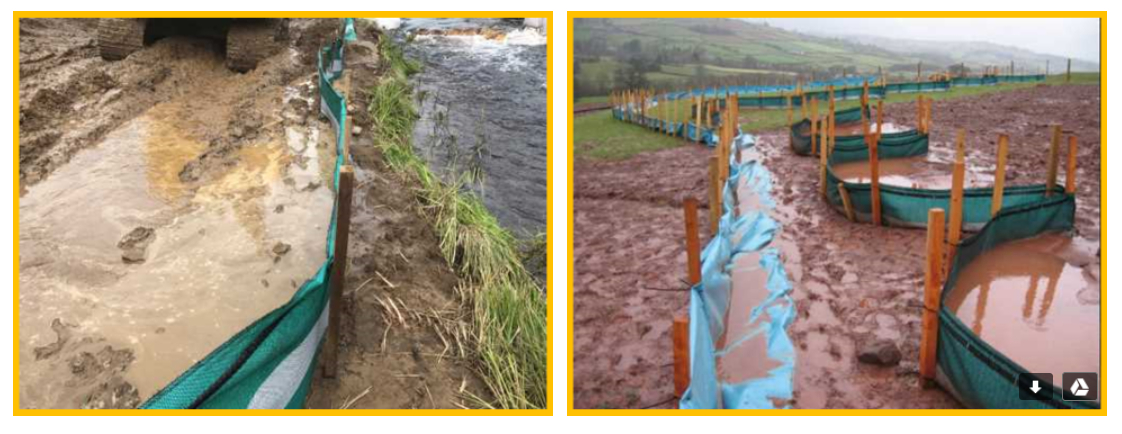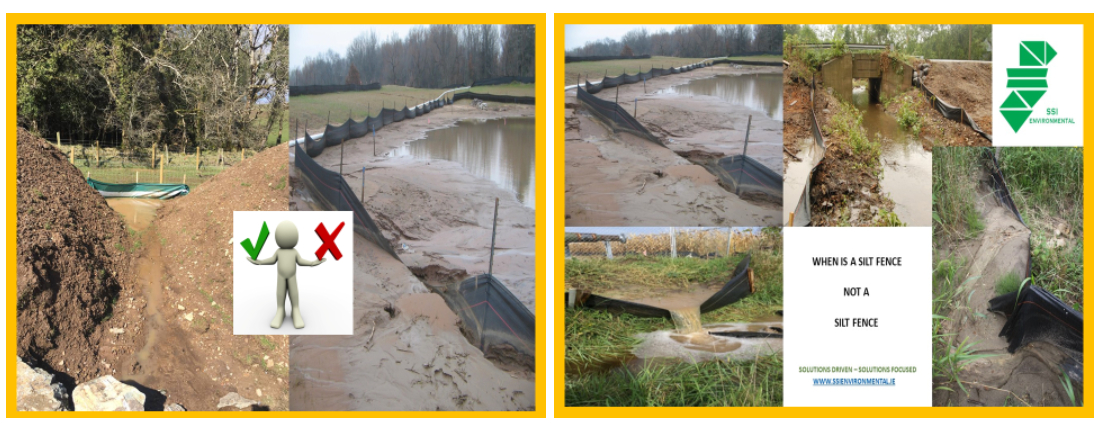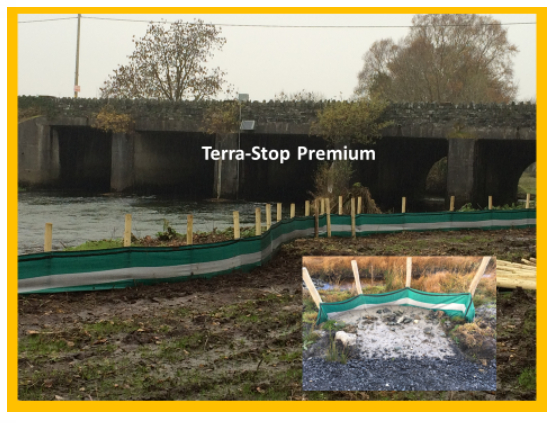
SILT FENCE REVIEW – Martin Sheridan
As you may be aware, there has been a significant emphasis directed towards the whole subject of Silt Control. A very important component of Silt Control measures is that of the Silt Fence. On all major jobs in proximity to water, there is generally a ‘Silt Fence’ specified. With the emphasis on design and performance of such Silt Fence becoming more elevated as time goes on, we now find more and more companies supplying their solutions. With that in mind I would like to draw your attention to the whole area of specification and please consider the amount of rainfall we receive per annum. I am afraid that without a very precise and definite specification , companies interpretation of a silt fence can vary significantly . Hy-Tex Terra-Stop Premium has been the market leader both here and in the UK for over 20 years. We would suggest the following points are most relevant when choosing/specifying a ‘Silt Fence’.


1.Permeability: Terrrastop Premium has a Flow Rate of 21L/m sq. per sec. based on European Standard ISO 11058 . The normal Silt fence sold in Ireland generally has 7L/m sq. per sec. We have seen a huge amount of Silt Fence failure last year in Ireland and the Low flow rate on a lot of these ‘silt fences’ is a contributing factor.
2.Micron Size : Hy-Tex Terra-Stop Premium Silt Fence has a micron size of 180 . This increases as silt builds up against the fence which give an additional level of filtration
3. Tensile Strength: Tensile Strength of premium is 22Kn/m . This is another important factor
4. Trapezoid Tear Strength: .48kn . If the Silt Fence tears in situ ,this can have catastrophic consequences
5. Reusable: Hy-Tex Terra-Stop Premium is a very durable product which means it can be moved from Job To Job which in turn will save money
6. CE Mark: Self Explanatory
7. Independent Study: Edinburgh University Dissertation ‘Prevention of Diffuse Pollution from Active Forestry Harvesting Sites concluded “The Hy-Tex(Terrastop Premium)material appears to be the most suitable material for use as sediment retention as it has the most consistent performance between differing soil types retaining the highest volumes of sediment for both gley and peat solutions .
Additional Follow on Briefing on Silt Fences.
What is involved in specialised silt fence fabric?
The Problem
Many construction, forestry and farming activities result in disturbed or bare ground that is vulnerable to weather erosion. The silt laden run-off, plus site debris and other pollutants, often contaminates surrounding land, rivers, streams, lakes and drains – resulting in significant environmental diffuse pollution and potentially costly fines.
However, due to the on-going nature of such work, it is generally not possible to protect exposed surfaces until the project is complete. So storm water from such sites represents a major non-point source of diffuse water pollution in Ireland.
The Solution
Terrastop™ Premium is a special, high quality, permeable, technical filter fabric for storm water surface runoff pollution management. Terrastop™ can be installed as an entrenched vertical entrapment fence, and is designed to intercept and detain storm water run-off, trapping harmful silt through settlement and filtration before it leaves the site.
The benefits of the silt fence are increasingly becoming recognised in Ireland.
Silt fences have also been used extensively in other countries for many years, and their proven performance (Intercepting up to 86% of suspended solids [Horner et al. 1990]) has made them a standard Best Management Practice on a diverse range construction projects, while in-depth research and practical experience has identified the most important characteristics for effective results.
Kirsty Liddon’s Edinburgh University Dissertation “Prevention of Diffuse Pollution from Active Forestry Harvesting Sites:” concluded “the Hy-Tex [Terrastop Premium] material appears to be the most suitable material for use as sediment retention as it has the most consistent performance between differing soil types retaining the highest volumes of sediment for both gley and peat solutions.”
Contact SSI Environmental today
THE DO LIST OF SILT FENCING
Do install it right the first time
Silt fencing consists of two basic components: the geotextile fabric and the support posts. The fabric must be trenched-in and backfilled, and the soil compacted around it. Then the posts are sunk. Posts can be either steel or wood. Obviously, steel will be stronger and last longer, but wood posts are adequate for most uses, especially short-term projects.
First, determine where on the site silt fencing is needed. Some sites will require more than others. Flatlands won’t need as many as hilly sites, but large open sites will certainly call for more silt fencing than smaller ones.
Silt fencing works through ponding. It allows runoff water to gather, and for sediment to sink while the water itself slowly soaks into the ground or evaporates. Most silt fences will probably be at or near the perimeter of the project. Silt fencing is more effective when it follows natural contours of the job site. Sometimes a “J” shape or long shallow curve—known as a smile— will create the correct ponding action.
Do use the correct method for the job
Installing good silt fences is a simple process that can be done using hand labour or by machine. The machine approach offers two big advantages: speed and consistency. Manual labour can do the same job, but it’s going to take longer.
The manual approach is great for a smaller job site, and experienced workers will ensure a correct installation. It all depends on your needs. If you’re doing it by hand, you need to dig a trench six inches deep or more. Then you lay in the fabric, backfill the dirt, make sure it is compacted and, finally, install posts to keep the fence in place.
On a larger job, it would probably behove you to install the silt fence by using a silt fencing machine. It is less time consuming and makes it much easier. These machines slice directly into the soil using a specially-shaped blade, simultaneously trenching, instal-ling the fabric and backfilling all in one pass.
Do maintain the silt fences
Although cost effective and easy to install, silt fences can create a fair amount of maintenance in certain circumstances, such as original installation of the fence.
Say you’re working on a large construction site where there’s constantly heavy traffic through the area. In their hurry, a driver fails to notice a row of wattles or a silt fence and drives right over them. These products will then need to be repaired or replaced.
It means buying more materials and paying more to repair and reinstall that portion of the damaged fence. And because there’s such a heavy bustle of traffic on that site, there’s always the possibility that these devices will accidently be run over and destroyed all over again. Clearly marking vehicle paths through the site will certainly help avoid damage, but the key thing is to repair damaged fences immediately.
Silt fencing should be inspected on a regular basis, especially after each rain event. If stakes are broken, fabric is torn or there are gaps between fabric and the ground, the fence should be replaced immediately. Sediment should be removed regularly when it reaches a third to one-half of the fence height.
Contractors need to know that silt fence isn’t a cure-all. They can’t just wrap their site in silt fence and say it’s done. Some people try to use it for concentrated flow, but it is designed so that sheet flow will pond against it and slowly let the water out. In concentrated flow, it can be undercut or topple.
In order to function, silt fence fabric must be firmly entrenched in the ground. While installation isn’t difficult, it’s often inconsistent. Even one gap in the fence between the ground and the fabric can render the whole fence useless.
Do use the right amount
How much silt fencing do you really need? Generally, you would install a silt fence around the outside of the site; however, you need to consider any storm drains that are in place where water can run off and enter the local water supply.
A rule of thumb is to allow roughly 30.48 meters of silt fence for every 10,000 feet of area on the job site. Multiple runs of fence make a stronger installation and reduce flow-rates on downhill slopes. It is recommended that you should not run more than 200 feet before starting a new fence.
Now let’s look at some things you definitely don’t want to do.
THE DON’T LIST OF SILT FENCING
Don’t short-change your need for posting
An ideal silt fence installation should have posts anywhere from four to seven feet apart. If you’re running twenty feet between posts, your fence won’t have the strength to hold up against a heavy flow of water. Remember that a silt fence should be able to withstand an 18- inch depth of standing water and still function properly.
Posts can be secured to the fence fabric using plastic ties, wire twists or staples (for wood posts). Fabric should be secured near the top of the post and more than one fastener should be used per post.
One common mistake is to install the posts before backfilling the soil. This undermines the stability of the fence. If you stake a fence into loosely compacted soil, it runs a fairly high risk of toppling at the first contact of high water flow or high winds.
Don’t turn your back on it
Even perfectly installed silt fencing needs to be inspected on a regular basis, and definitely after every rain or weather event. Plus, with the fast pace of work it’s easy for someone to run over a length of fence when visibility is low, or people are behind schedule.
Hustling on the job can be great, but don’t allow broken or damaged fences to stand—it will do more harm than good. Any time that a silt fence has been damaged, replace it right away—certainly before the next rain day. Existing posts can be left in place and new fabric laid between them.
Rebuilding silt fence is a very good time for a quick audit, to see if the fence is working properly or if its position needs to be adjusted for better ponding and retention. Remember to remove collected sediment when it gets to a height of 18 inches. This allows the fence to maintain its filtration and keeps it from overflowing as sediment builds up.
Don’t ignore the alternatives
For example, a flexible sediment control barrier is designed to return to its original shape every time it compresses, so you can drive over it repeatedly. This is very helpful in terms of accessibility, because drivers don’t have to worry about finding a way around them.
Don’t just lay the fence down
A major mistake is made by workers not trenching-in the silt fence cloth during installation. Fence cloth that’s just laid flat on the ground can’t possibly resist the pressure of standing water—even just a few inches.
Trenching-in the cloth gives it a solid anchor in the ground, and makes it nearly impossible for runoff water to get past the fence barrier. Even though the fence cloth is not meant to filter out all the water that collects behind it, a silt fence that has a gap of any kind between the fence cloth and the ground will not do its job of collecting sediment, and will allow silt to pass into the local water supply.
Don’t just walk away from it when the job is done
It‘s important to remember that silt fence removal is as much a part of the job as installation. Temporary silt fencing that has become a permanent part of the landscape is becoming a common eyesore, even on upscale job sites. Granted, that some sites may need ongoing sediment management, but construction silt fencing lacks a finished look and is not meant to be a long term solution to sediment and runoff problems.
Designing permanent collection ponds and water features into the overall landscape plan is the better way to handle runoff problems and regulations. Even on a sprawling corporate site, leftover construction silt fence is a nasty look that’s out of keeping with the sleek buildings and landscape you’ve worked hard to put in place.
There is no magic bullet for effective sediment control. There are many different ways you can trap and control runoff soil as it gets carried away by storm water. It is your responsibility to decide which approach works best in any given situation. Silt fences and other devices are just one piece of a bigger puzzle. They each perform similar tasks, but in different ways. The trick is knowing how to best utilise these materials on any given job. These Dos and Don’ts will help you get there every time.
Call SSI Environmental on 01 8665676 for silt fencing products or www.ssienvironmental.ie
Source: soilerosiononline.com
